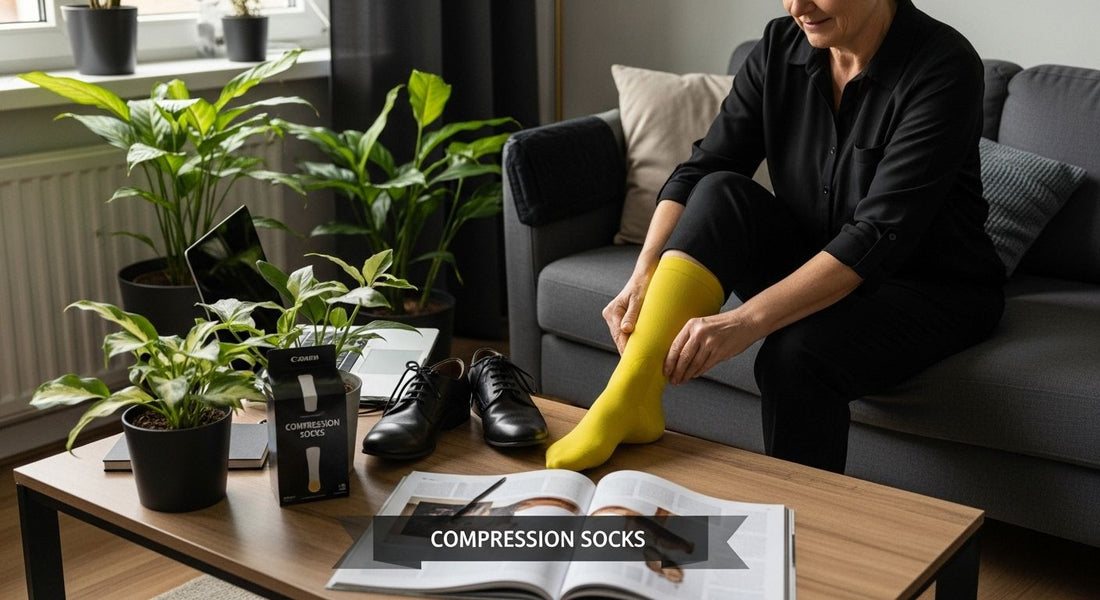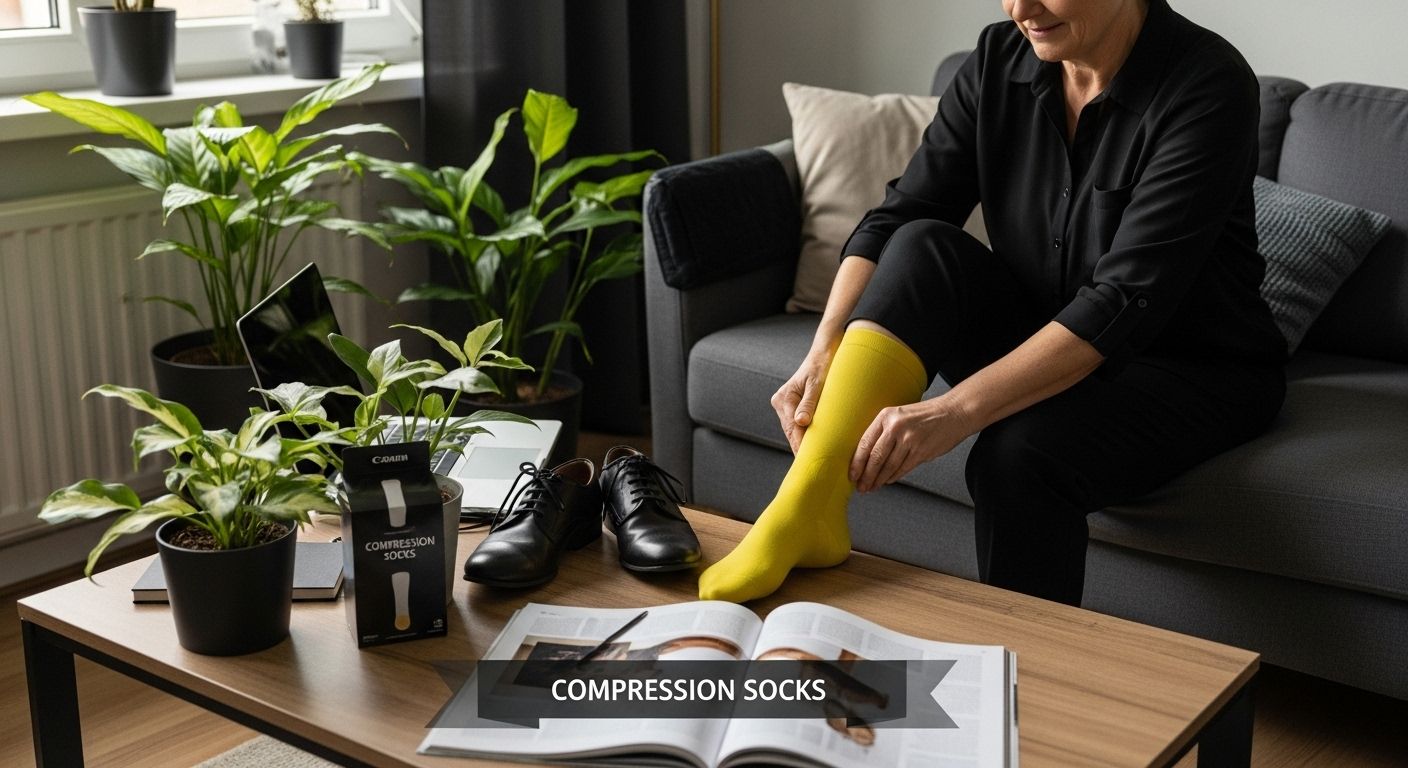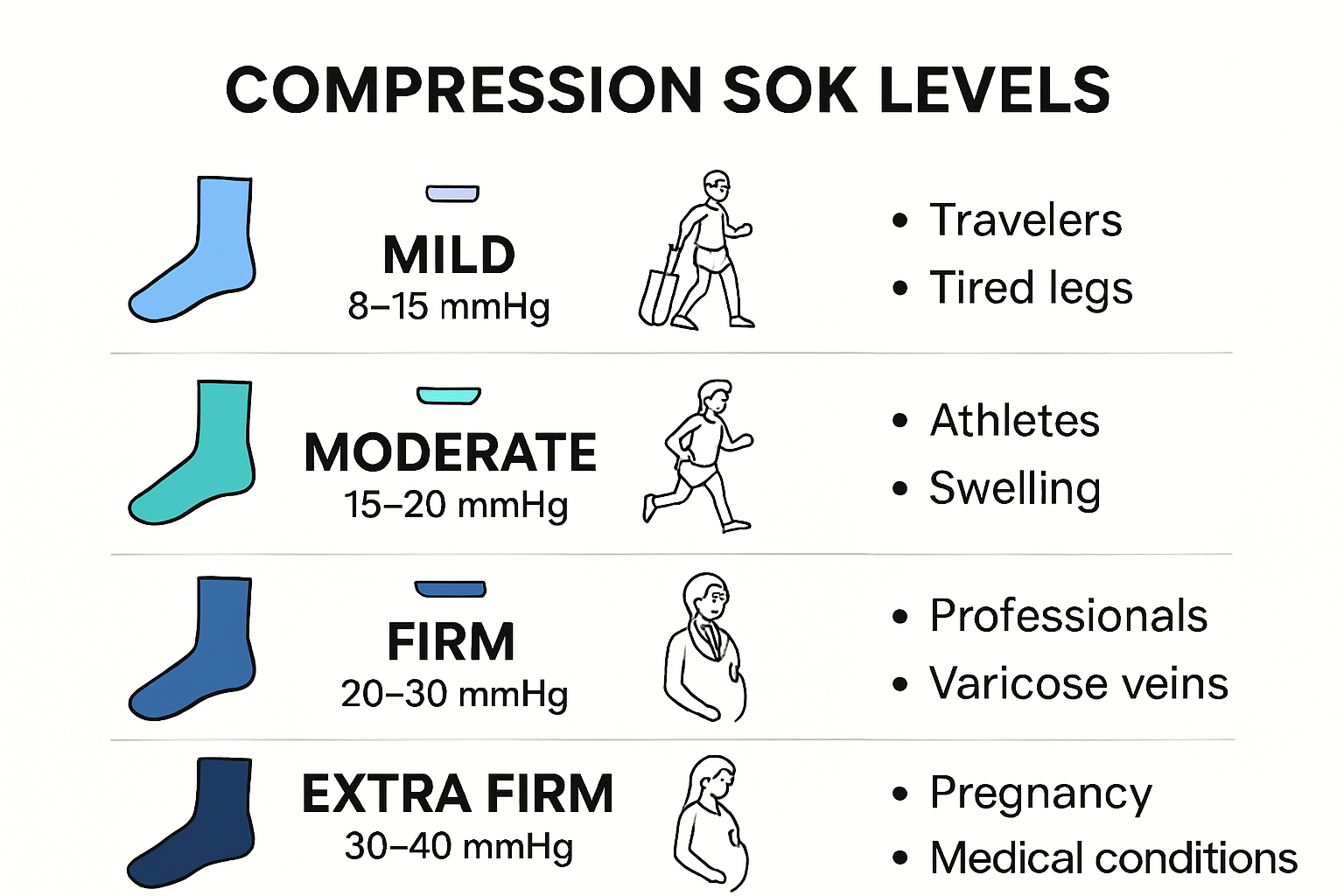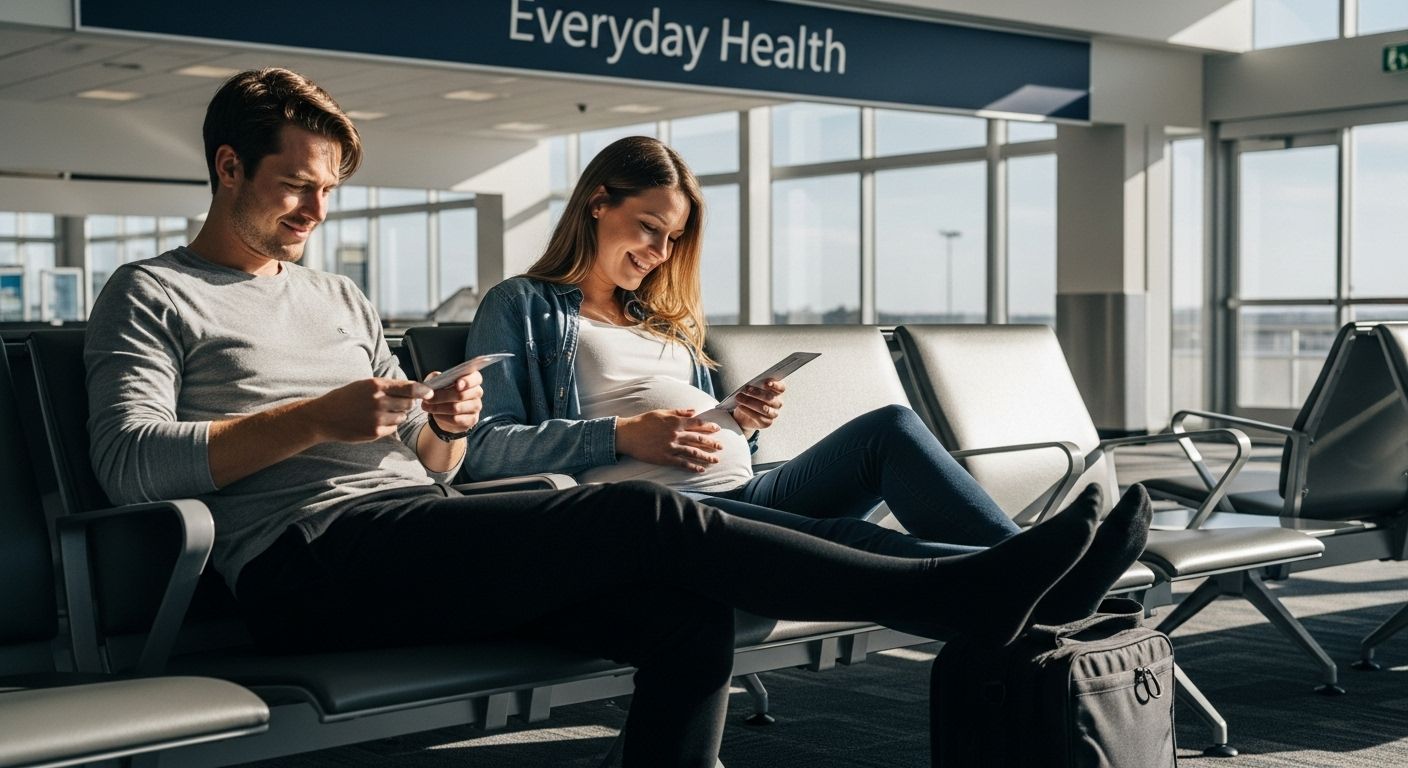
Compression Socks for Everyday Use: Benefits and Best Tips
Share

Sore legs after a long workday or endless hours stuck at a desk are more common than most people admit. Surprising, right? Compression socks are proven to improve blood flow and can actually reduce your risk of leg swelling and blood clots by up to 60 percent. Most think these socks are just for athletes or hospital recovery but the reality is everyday use could completely change how your legs feel by the time you get home.
Table of Contents
- How Compression Socks Support Everyday Health
- Who Should Wear Compression Socks Daily
- Choosing the Right Compression Socks for You
- Tips for Comfort and Safe Everyday Use
Quick Summary
| Takeaway | Explanation |
|---|---|
| Compression socks improve circulation | They promote blood flow, especially for those sitting or standing for long periods. |
| Beneficial for various professions | Suitable for healthcare workers, office employees, and athletes for comfort and recovery. |
| Specific groups gain more from them | Individuals with medical conditions or pregnant women find substantial daily relief and support. |
| Select the right compression level | Different levels are tailored for specific health needs; consult a professional for guidance. |
| Follow care instructions for longevity | Proper washing and maintenance extend the life and effectiveness of compression socks. |
How Compression Socks Support Everyday Health
Compression socks provide remarkable support for everyday health by promoting better circulation and preventing various lower body complications. These specialized garments offer more than just temporary comfort they are a proactive approach to maintaining overall wellness.
Enhancing Circulatory Function
Compression socks work by applying graduated pressure to your legs, helping blood flow more efficiently from your lower extremities back to your heart. Research from Harvard Medical School indicates that these garments can effectively reduce leg swelling and prevent blood clots. The strategic compression helps combat gravity’s natural pull, supporting your body’s circulatory system throughout daily activities.
People with sedentary jobs or those who spend extended periods standing can particularly benefit from compression socks. By improving blood circulation, these garments help prevent conditions like venous insufficiency and reduce the risk of developing deep vein thrombosis. Medical research from the National Institutes of Health confirms that consistent use of compression socks can significantly improve lower limb blood flow.
Preventing Everyday Health Challenges
Compression socks are not just for athletes or patients recovering from medical procedures. They offer substantial everyday health benefits for various individuals. Occupational wellness is one area where these socks shine. Scientific studies demonstrate that workers in professions requiring prolonged standing or sitting can reduce lower limb edema by wearing compression garments.
For individuals experiencing leg fatigue, swelling, or mild discomfort, compression socks provide a non-invasive solution. They help manage symptoms associated with various conditions like diabetes, varicose veins, and pregnancy-related circulatory challenges. The gentle, consistent pressure promotes better blood circulation, reducing the likelihood of developing more serious health complications.
Daily Comfort and Prevention
Beyond medical benefits, compression socks offer everyday comfort. They can help reduce muscle soreness after exercise, prevent leg cramps, and provide support during long travel periods. Whether you’re a healthcare professional, office worker, traveler, or fitness enthusiast, these socks can be a valuable addition to your daily health routine.
If you’re interested in learning more about selecting the right compression socks for your needs, check out our comprehensive guide on choosing compression socks. Understanding the nuanced benefits and selecting the appropriate compression level can transform your daily health management approach.
Remember, while compression socks offer numerous health benefits, it’s always recommended to consult with a healthcare professional to determine the most suitable type for your specific health requirements.
Who Should Wear Compression Socks Daily
Compression socks are not a one-size-fits-all solution but offer targeted benefits for specific groups. Understanding who can benefit most from daily wear helps individuals make informed decisions about their personal health and wellness strategies.
Professionals with Sedentary and Active Lifestyles
Research from Geisinger Health reveals that multiple professional groups can significantly benefit from daily compression sock use. Healthcare workers who spend long hours standing, office professionals sitting at desks, and remote workers experiencing limited movement can improve their circulatory health.
Athletes and fitness enthusiasts represent another critical group. Compression socks support muscle recovery, reduce post-exercise swelling, and help prevent potential injuries. Runners, cyclists, and strength training professionals often integrate these garments into their daily recovery routines. The graduated pressure helps reduce muscle vibration and supports improved blood circulation during and after intense physical activities.
Medical Conditions and Health Challenges
Harvard Health Publishing highlights several medical conditions where daily compression sock use becomes crucial. Individuals with chronic venous insufficiency, varicose veins, and persistent leg edema can experience significant relief. People managing diabetes, who often struggle with lower extremity circulation, find compression socks particularly beneficial in preventing potential complications.
Pregnant women represent another group that can substantially benefit from daily compression sock wear. As pregnancy progresses, increased blood volume and hormonal changes can lead to leg swelling and discomfort. Compression socks provide gentle support, reducing the risk of developing deep vein thrombosis and alleviating leg fatigue.
Travel and Recovery Scenarios
MedlinePlus medical resources emphasize compression socks’ importance for individuals recovering from surgery or experiencing limited mobility. Patients with recent leg injuries, those confined to beds, or individuals with restricted movement can prevent blood clots and support healthy circulation.
Frequent travelers, especially those on long-haul flights, should consider daily compression sock use. Extended periods of sitting during travel can increase the risk of blood clot formation. Compression socks help mitigate this risk by promoting blood flow and reducing leg swelling associated with prolonged sedentary conditions.
If you’re uncertain about the right compression level for your specific needs, explore our comprehensive guide to selecting compression socks to make an informed decision tailored to your lifestyle and health requirements.
Remember, while compression socks offer widespread benefits, consulting with a healthcare professional can help determine the most appropriate compression level and usage strategy for your individual health profile.
Choosing the Right Compression Socks for You
Selecting the perfect compression socks requires careful consideration of multiple factors. The right pair can significantly enhance your comfort, support your health goals, and provide optimal therapeutic benefits.
Understanding Compression Levels
Harvard Health emphasizes the critical importance of choosing the correct compression level. Compression socks are typically measured in millimeters of mercury (mmHg), with different levels designed for specific health needs:
- Mild Compression (8-15 mmHg): Ideal for daily wear, preventing minor swelling, and providing general leg comfort
- Moderate Compression (15-20 mmHg): Recommended for travelers, pregnant women, and those with mild circulatory issues
- Firm Compression (20-30 mmHg): Suitable for managing more significant medical conditions like varicose veins and post-surgical recovery
- Extra Firm Compression (30-40 mmHg): Prescribed for severe medical conditions and typically requires healthcare professional guidance

Here’s a quick reference table to help you select the appropriate compression level based on your needs and medical considerations.
| Compression Level | mmHg Range | Recommended For |
|---|---|---|
| Mild Compression | 8-15 mmHg | Daily wear, minor swelling, general leg comfort |
| Moderate Compression | 15-20 mmHg | Travelers, pregnant women, mild circulatory issues |
| Firm Compression | 20-30 mmHg | Varicose veins, post-surgical recovery, significant problems |
| Extra Firm Compression | 30-40 mmHg | Severe medical conditions (with professional guidance) |
Measuring for the Perfect Fit
Properly fitting compression socks is crucial for their effectiveness. Incorrect sizing can reduce therapeutic benefits and cause discomfort. Measurements should include:
- Ankle circumference
- Calf circumference
- Leg length
- Body weight and height
If you’re unsure about your measurements, our comprehensive guide to selecting compression socks can help you find the perfect fit. Professional sizing ensures maximum comfort and therapeutic effectiveness.
Additional Considerations for Selection
Beyond compression levels and measurements, several other factors influence your sock selection. Material composition matters significantly. Look for breathable fabrics like nylon, spandex, and cotton blends that offer moisture-wicking properties and durability.
Consider your specific lifestyle and health requirements. Athletes might prefer different designs compared to office workers or individuals managing medical conditions. The News International recommends consulting healthcare professionals to determine the most appropriate compression sock type for your individual needs.
Key selection criteria include:
- Intended use (medical, athletic, travel)
- Personal comfort preferences
- Specific health conditions
- Activity level
- Skin sensitivity
While choosing compression socks might seem complex, understanding these fundamental aspects will help you make an informed decision. Always prioritize professional medical advice when selecting compression levels for managing specific health conditions.
Remember that compression socks are an investment in your health. Taking time to select the right pair ensures you receive maximum benefits and comfort throughout your daily activities.
Tips for Comfort and Safe Everyday Use
Compression socks are powerful health tools, but their effectiveness depends on proper application, maintenance, and daily wear. Understanding the nuanced techniques for comfortable and safe use ensures you maximize their therapeutic potential while maintaining personal comfort.
Proper Application Techniques
Harvard Health provides critical guidance for putting on compression socks effectively. The best time to apply these garments is in the morning when leg swelling is minimal. To ease application, consider these professional strategies:
- Turn the sock toe inside out before pulling it up
- Use talcum powder to reduce skin friction
- Wear rubber gloves to improve grip
- Ensure hands are clean and dry
- Smooth out wrinkles to prevent pressure points
Pay special attention to how the sock sits on your leg. Proper positioning prevents uncomfortable bunching and ensures consistent compression throughout the day. The sock should feel snug but not painfully tight, with no significant folding or rolling at the top or bottom.
Daily Wear and Care Recommendations
MedlinePlus medical resources recommend removing compression socks at night to allow your skin to breathe and circulation to normalize. When wearing these garments daily, consider these essential practices:
- Inspect your skin daily for signs of irritation
- Rotate between multiple pairs to extend garment life
- Avoid wearing the same pair multiple days without washing
- Check for signs of wear like thinning fabric or stretched elastic
Moisturize your legs before putting on compression socks, but allow the lotion to absorb completely to prevent fabric degradation. If you experience persistent discomfort or skin changes, consult your healthcare provider to ensure the compression level remains appropriate for your needs.
Maintenance and Longevity Strategies
Proper care extends the life of your compression socks and maintains their therapeutic effectiveness. While these garments are durable, they require specific maintenance. Our guide to compression sock care offers comprehensive insights into preserving your investment.
Key maintenance tips include:
To help you maintain comfort and ensure the safe use of compression socks, here’s a summary table of essential tips for daily wear, care, and longevity.
| Tip | Purpose | How-To |
|---|---|---|
| Apply in the Morning | Reduce swelling, easier fit | Put on before getting out of bed |
| Inspect Skin Daily | Prevent irritation or complications | Check legs after removing socks |
| Rotate Pairs | Extend garment life | Alternate between at least two pairs |
| Hand Wash & Air Dry | Maintain elasticity, prevent damage | Use lukewarm water, mild soap, air dry away from heat |
| Remove at Night | Allow skin to breathe | Take off before sleeping |
| Replace Regularly | Ensure effectiveness | Every 3-6 months or signs of wear (stretch, thinning) |
- Hand wash in lukewarm water with mild detergent
- Avoid wringing or twisting the fabric
- Air dry away from direct heat or sunlight
- Replace socks every 3-6 months or when they lose elasticity
Additionally, always have a backup pair. Compression socks can develop microscopic wear that isn’t immediately visible, so rotating between multiple pairs ensures consistent support.

Remember that compression socks are medical garments. While they offer significant health benefits, they’re not indestructible. Treat them with care, follow professional guidelines, and listen to your body’s response to ensure safe and comfortable everyday use.
Frequently Asked Questions
What are the benefits of wearing compression socks daily?
Compression socks can improve blood circulation, reduce leg swelling and discomfort, and prevent serious complications like blood clots and venous insufficiency, making them beneficial for individuals with sedentary or active lifestyles.
How do I choose the right compression level for my needs?
Compression levels are measured in mmHg. Mild compression (8-15 mmHg) is suitable for everyday wear, while moderate (15-20 mmHg) and firm compression (20-30 mmHg) are recommended for specific conditions. Consult a healthcare professional for guidance tailored to your individual health requirements.
How do I properly wear and care for compression socks?
Put on compression socks first thing in the morning to reduce swelling. Inspect your skin daily for irritation, rotate between different pairs to extend their lifespan, and remove them at night. Hand wash them in lukewarm water and air dry to maintain elasticity.
Can anyone wear compression socks, or are they only for specific health conditions?
While compression socks are highly beneficial for individuals with medical conditions like varicose veins and diabetes, they can also help professionals in sedentary or active jobs and athletes looking for muscle recovery support. They are suitable for a wide range of individuals seeking to improve their leg health.
Take Your Everyday Leg Comfort Further with Fit Stockings
If tired legs, daily swelling, or worrying about circulation have kept you from feeling your best, you are not alone. This article highlighted how compression socks can transform comfort and prevent health risks for anyone who stands or sits all day, faces chronic vein conditions, or wants support during pregnancy. The real difference comes from choosing the right medical-grade compression for your unique needs.
Visit our Home page – Fit Stockings to discover premium medical-grade stockings trusted by healthcare professionals. Explore top brands such as Jobst, and find a range of compression levels and styles designed for daily comfort and effective therapy. Ready to transform how your legs feel at work, during travel, or after long days? Start with Fit Stockings for personalized support and enjoy free shipping and easy returns. Now is the best time to feel the relief and confidence you deserve.
Recommended
- How to Choose Compression Socks: A Helpful Guide for 2025 – Fit Stockings
- Can Compression Socks Be Too Tight? What You Need to Know 2025 – Fit Stockings
- Compression Socks for Walking: Health Benefits and Top Uses 2025 – Fit Stockings
- Diabetic Compression Socks: Benefits, Uses, and How to Choose (2025) – Fit Stockings

